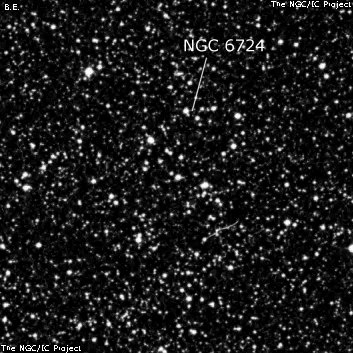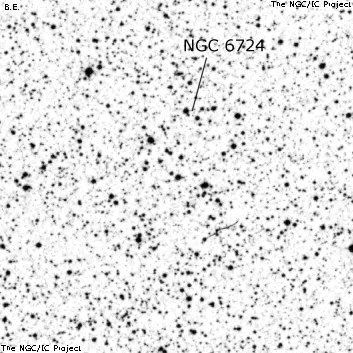NGC/IC Project Restoration Effort
(This is a very very beta version)
NGC6724


Basic Information
Location and Magnitude
Right Ascension: 18:56:46.0
Declination: +10:25:42
Constellation: AQL
Visual Magnitude:
Historic Information
Discoverer: Herschel J.
Year of discovery: 1828
Discovery aperture: 5.0
Observational
Summary description: Cl
Sub-type: *Grp
Corwin's Notes
=====
NGC 6724 is described by JH simply as "A cluster discovered with the 7-feet
(sic) equatorial, Sept 5, 1828." He puts a plus/minus sign on the RA which
he lists to only a full minute of time, though the NPD is given to his usual
precision of an arcsec.
Checking the Herschel Archive material, however, shows that both RA and NPD
are marked with plus/minus signs. This is recorded in his observing "Journal
No. 1" as number 45 in Sweep 172 where he copies an entry from his "Equatorial
Book": "Discd a Cluster VIII. Cl VIII nova. Vide Equatorial Book No. 201
-- RA 18 49+- PD 79 51 30 +-." (For reference, this is page 110 of 120 in
file "J0001-0002-0002.pdf" on the first DVD of the three in the Herschel
Archives.) Unfortunately, the Equatorial Book from Slough seems to not be
included in the Archives, so checking that will have to wait until it can be
located.
The crude position is confirmed, at least in RA, in JH's "Register of Objects
observed in Sweeps ..." (J0001-0004-0001.pdf, page 117), where this is the
only entry under 18h 49m. However, the NPD looses its +- sign. The remainder
of entry there reads "Cl VIII Discd. with Equatorial Sep. 5 1828. See Eql.
Papers. No 201", confirming the information from the observing Journal.
About five arcmin northwest of his place is a small (5 arcmin by 3 arcmin)
clump of stars, a dozen of which are bright enough to be in GSC. Given the
paucity of information, though, the object could also be NGC 6709, a much
richer cluster 10 minutes west at the same declination. Pending a study of
the Slough Equatorial Book, I am going to adopt the poorer clump of stars for
this number -- though with a colon to flag the uncertainty inherent in the
observation.
Finally, I note that Brent Archinal reports two observations of an obvious
group of stars at JH's position in his Webb Society monograph. Archinal and
Hynes have a very long note about this object, collecting observations by
several different veteran observers. In the end, they somewhat reluctantly
adopt the same clump of stars that I note here.
Steve's Notes
=====
NGC 6724
17.5" (7/24/95): at 100x appears as a small indistinct group in a rich Milky Way field. Stands out better at 220x which increases the number of stars to 15 in a 2.5'x2.0' region (slightly elongated E-W). There are five brighter mag 12-13 stars and 10 faint stars in this group and visually it appears to be an asterism.



